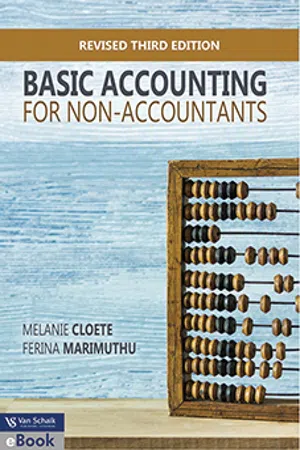
Basic accounting for non-accountants 3 Revised
Cloete M, Marimuthu F
- English
- ePUB (mobile friendly)
- Available on iOS & Android
Basic accounting for non-accountants 3 Revised
Cloete M, Marimuthu F
About This Book
Accounting is a system of gathering, analysing, recording, reporting and interpreting financial information that will assist in making informed business decisions. The accounting discipline is constantly changing in response to the external environment, and is both stimulating and far-reaching. Basic accounting for non-accountants is an introductory text that covers aspects of financial accounting, cost and management accounting and financial management. Basic accounting for non-accountants includes comprehensive illustrative examples that are easy to understand. All chapters have been updated and additional tutorial questions have been provided to give students sufficient practice to reinforce their newly acquired knowledge. This third edition also covers a new topic – capital budgeting.
Frequently asked questions
Information
Introduction to accounting
Chapter outline
- 1.1 What is accounting?
- 1.1.1 Definition of accounting
- 1.1.2 Nature of accounting
- 1.2 Users of accounting information
- 1.3 How useful is accounting information?
- 1.4 The basic business forms found in South Africa
- 1.4.1 Sole trader
- 1.4.2 Partnership
- 1.4.3 Close corporation (CC)
- 1.4.4 Company
- 1.5 Types of business activity
- 1.5.1 Service businesses
- 1.5.2 Manufacturers
- 1.5.3 Wholesalers
- 1.5.4 Retailers
- 1.6 Considerations before commencing a business
- 1.7 The accounting field
1.1 What is accounting?
1.1.1 Definition of accounting
- gathering – the bringing together of all financial information that has an effect on a specific business
- analysing – determining how the financial information will affect the business
- recording – inputting the financial information through proper accounting processes
- reporting – summarising all financial information for a given period of time so that it can be read and understood in a more condensed format
- interpreting – preparing an analysis of the summarised reports to allow users to make informed decisions about the business.
1.1.2 Nature of accounting
1.2 Users of accounting information
- Owners – use accounting information to determine whether their business is profitable and financially viable over a long period of time.
- Managers – use accounting information to ensure that the business operates efficiently and to solve problem areas highlighted in the accounting information.
- Employees and their representatives – use accounting information to determine whether their employer is able to provide stable employment and remuneration.
- Customers – use accounting information to determine whether the business can provide them with the products that they require for a long period of time.
- Competitors – use accounting information to maintain a competitive edge.
- Lenders – use accounting information to determine whether the business would be able to repay a loan and the interest on it.
- Government – uses accounting information to determine whether the business should be registered and, if so, how much tax should be paid.
- Suppliers – use accounting information to determine whether the business is able to make payments for goods purchased on credit.
- Investment analysts – use accounting information to determine whether the business would be a good investment, and to assess the risk and return on an investment in the business.
1.3 How useful is accounting information?
- Comparability – the information must be comparable to the financial information presented by other organisations and also various accounting periods within the organisation, so that users can identify trends in the performance and financial position of the organisation.
- Understandability – the information must be readily understandable by all users of financial statements.
- Relevance – the information reported must be relevant to the needs of the users. This may involve reporting information that could influence the e...